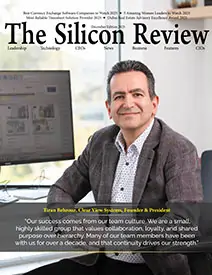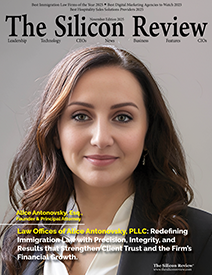10 Best Healthcare Companies to Watch 2021
John Kalix, SOC Telemed CEO: “We partner with healthcare organizations to bring clinicians and patients together using innovative technologies to improve clinical care and patient outcomes in a measurable way.”
The Silicon Review
![]()
SOC Telemed is a nationwide leader in the growing acute care telemedicine space. The company’s customers include 19 of the 25 largest health systems in the nation, and it has enabled nearly 1,000 facilities in 47 states to manage complex, acute workflows and provide life-saving care. SOC Telemed partners with healthcare organizations to build sustainable specialty programs in a multitude of clinical service lines through optimization of clinical staff. Built on proven and scalable infrastructure as an enterprise-wide solution, SOC Telemed’s proprietary software technology, Telemed IQ, rapidly deploys and seamlessly optimizes telemedicine programs across the continuum of care, allowing the company to virtually deliver time-sensitive care when and where patients need it most.
In conversation with John Kalix, CEO of SOC Telemed
Q. What are the challenges you had to face while developing solutions for SOC Telemed? How did you overcome them?
While acute care telemedicine was not entirely unknown, it was very much an early-adopter type of technology until the onset of the pandemic. Due to the pandemic, a five-plus year adoption curve was shortened to a matter of months, which created access, quality, and cost challenges across healthcare. One of the challenges in developing the technology platform has been ensuring our offerings are effective for every partner. Over the course of 17 years and tens of thousands of touchpoints, we truly understand provider-initiated patient care, the importance of clinical quality, and physician, nurse, and other clinical workflows. Part of this journey has been scraping our knees and bumping our elbows as we facilitated more than 3 million virtual consultations.
I liken this process to building blocks that can be configured in a multitude of different ways. Every time a new challenge would come up with our partners, we built a solution for it. Because challenges continued to arise as our hospital partners became more sophisticated, we built a platform that allowed us to configure solutions using different combinations of these blocks together, creating a variety of solutions to serve different specialties and clinicians. We currently have 20+ specialties in use on our platform today. Even though telemedicine has existed for a number of years, this is still a cutting-edge frontier. Clinicians are no longer bound to working inside the four walls of their hospital. We can now virtually deliver clinicians in numerous specialties inside of the emergency room, inpatient floors, and many other care settings. We overcame the challenges of building a thriving acute telemedicine platform through the scope, scale, and unwavering dedication of our team.
Q. How does your solution align with the existing medical practice?
Telemed IQ is a true enterprise-wide platform, enabling providers to deploy, optimize, and scale a telemedicine program rapidly, seamlessly, and cost-effectively across all care sites. Telemed IQ provides a customized solution in any specialty. Providers can use our clinicians or their own. If providers are looking to support a single specialty, our physicians support some of the most critically understaffed areas, including ICU, pulmonology, psychiatry, neurology, infectious disease, endocrinology, cardiology, maternal-fetal medicine, and nephrology. This alignment enables hospitals and other healthcare organizations to strengthen their care models, patient outcomes, and the health of the organization itself.
Q. Tell us in brief about the new revenue streams generated by your solutions.
First, we’re unlocking value by enabling the hospital to offer new services. Take, for example, a hospital that does not have full-time access to a neurologist. As a result, they are unable to achieve stroke certification. Ambulance services know which hospitals are stroke certified, and if the nearest hospital isn’t, that patient will be driven to a hospital up to two hours away for treatment. What does this mean? The longer a patient waits before receiving treatment, the higher the impact the stroke has. As they say in neurology, time is the brain. Additionally, financial challenges coincide with those clinical challenges. If ambulances consistently bypass a hospital without stroke certification to drive to one that has it, revenue goes to another hospital outside of that local community. That is valuable revenue that has an effect on the hospital’s financial viability.
Every hospital in the country can and should be stroke certified. Through an acute care telemedicine platform like ours, we can ensure a neurologist is on call 24/7, enabling stroke certification, improving patient care, and opening up a new revenue stream. We have many close partners we have worked with to make that exact impact, including those without on-site neurologists.
Another area to consider is psychiatry. In an Emergency Department today, a mental health patient in crisis must be seen by a board-certified psychiatrist to assess whether they should be admitted or released to outpatient care. While many EDs have a psychiatrist on call during the weekdays, psychiatrist shortages are increasingly common during the evenings and weekends. As such, patients may wait in the ED for 12 or more hours before being seen by a board-certified psychiatrist. As some of the most challenging patients for staff to manage physically, a nurse must attend to the patient until a doctor arrives. Therefore, this creates staffing challenges while that patient is occupying a room that could be used for another patient in need of acute care. Our platform provides an available psychiatrist around the clock, relieving the gridlock that’s happening in the ED. As we see the start of what is expected to be a significant increase in mental health-related volume, this access becomes increasingly important. We’re focused on improving patient care while saving the hospital money and improving quality metrics.
Finally, hospitals are looking to increase the case-mix. Doctors want to stabilize a patient but also have the patient recover on-site instead of being transferred to another hospital. Lack of access to specialists at their facility is a primary hindrance to being able to retain patients, which is where we come in through our comprehensive array of solutions. There are multiple benefits to keeping patients in the hospital and avoiding transfers out of the facility. From a quality standpoint, it is beneficial for the patient to stay in the same hospital where they were first treated to maintain continuity of care. Financially, it is better for the hospital to keep that patient in their hospital rather than transfer them out to another facility with access to specialists. This is specifically important in ICUs, and we have the experience through our strong and collaborative team to achieve these clinical and financial goals.
Q. Many hospitals are focused on the financial aspect of healthcare and not the quality outcomes. How do you maintain the affordability of your solutions for mass adoption?
So much of healthcare is related to the cost of care. Pre-COVID-19, every dollar mattered, and now it seems like the financial scrutiny has only increased as resources have been stretched to the limit. It’s important to keep hospitals viable for their local communities. With the help of technology, we enable hospitals to offer robust clinical services in their own facility through on-demand access of physicians. This lets hospitals use only the clinical resources they need versus a full on-site model staffing, thereby making healthcare more affordable. Through our platform, specialists can see one patient per hour instead of every 90 minutes or two hours. Our physicians enjoy the clinical work because they get to see very challenging patients. By the nature of telemedicine, these specialists develop an unmatched “clinical muscle memory” that is born of scale. They are seeing and treating not only more cases, but more complex cases than the average in-person specialist would see in the same period of time. What’s more, it provides savings for the hospital. There’s no windshield time, hallway time, travel time, and time is money. The fact that we can look to fractionalize a specialist’s time and allow a hospital to have access around-the-clock to specialists makes this a much more affordable solution than employing additional clinical staff or hiring locum tenens to fill the gaps.
Q. Do you have any new services ready to be launched?
Our mission is to bring specialty care to every patient in the country. We know there are physician shortages in most specialties, and we are working relentlessly to meet the challenge. To that end, we recently merged with Access Physicians to become the largest acute-dedicated telemedicine provider in the nation. Access Physicians brings a network of clinicians in multiple specialties, growing our network to over 750 physicians and allowing us to offer cardiology, endocrinology, nephrology, infectious disease, maternal-fetal medicine, and others, in addition to our legacy psychiatry, neurology, critical care, and pulmonology solutions.
We know that hospital systems have vendor fatigue, and this business combination allows us to be hospitals’ single solution provider for all acute care telemedicine needs. There are so many different SaaS and services providers, but the resources required to work with so many are constrained. We can provide a common solution that crosses geographies, specialties, and other boundaries as the single solution provider. This goes back to our building block analogy—we didn’t just think about the workflow for one specialty but workflows for the physicians, nurses, and supporting on-site staff working with our specialists. Creating our platform in this way means our solutions are very configurable and scalable. Anywhere there’s a need, we will let customers and hospitals guide us to where that need is. And we will absolutely drive to be innovative there.
Q. What does the future hold for your company and its customers? Are exciting things on the way?
I look at this as the dawn of electricity, where we can literally and fundamentally change healthcare. We have a very innovative team, and we’re excited about the future of healthcare. While every patient is different, there are some systemic needs. There will never be enough physicians and nurses to take care of the growing population, and I think that leads to wild opportunities for innovation. We’re excited about that. We’re excited to answer the call to change the curve of healthcare and to provide fiercely better care over time—amazing things can happen.
Meet the leader behind the SOC Telemed
John Kalix brings a diverse healthcare background to his role as CEO. He has previously worked in healthcare technology and separately with physician groups. Combining these experiences makes him uniquely qualified to lead SOC Telemed. Kalix spearheads SOC Telemed’s efforts to be the leader in the field of acute telemedicine by using technology to bring together the best clinicians and the patients who need them. He comes to the leader in acute telemedicine with more than 25 years of experience in healthcare. Kalix most recently served as Executive Vice President and Chief Operating Officer at North American Partners of Anesthesia (NAPA). While there, Kalix led all clinical and operational elements of the business, helping grow NAPA from a small regional physician practice management company to the nation’s largest hospital, ASC, anesthesia, and pain management business with more than 5,000 employed clinicians.
_2025-12-15_12-44-58.webp)


_2025-11-17_06-38-14.webp)

 (1)_2025-10-21_13-35-14.webp)
